In my experience, choosing the right online training software can be a game-changer for any organization. It’s not just about digitizing learning; it’s about empowering your team, enhancing skills, and driving growth.
That’s why I’ve put together a list of the 15 best online training tools available today, accompanied by insights into key features, benefits, and future trends.
Let’s dive in and explore these powerful tools for transformative learning!
| Training Software | Best For | Pricing |
|---|---|---|
| ProProfs Training Maker | Employee training in skills & compliance | Forever free for up to 10 learners. Paid plan starts at $1.99/learner/month for large teams. Billed annually. |
| Docebo | AI-based & scalable learning | $25,000/year |
| Moodle | Free & open-source training software | Free version available. Starts at $122.13/year. 50 users. 250 MB storage |
| Seismic Learning | Sales & customer service training | Custom pricing |
| Litmos | Engaging courses & programs | Starts at $6/user/month |
| TalentLMS | Deployment-readiness | Starts at $69/month |
| LearnUpon | SMEs & training companies | $599/month |
| iSpring Learn | eLearning authoring | Starts at $2.29/user/month |
| Absorb LMS | Associations & non-profits | Approx. $14,500/year |
| Tovuti | Ready-to-use learning solutions | Custom pricing |
| Adobe Learning Manager | AI recommendation engine | The team plan starts at $45.25/month/license |
| 360Learning | Collaborative learning | $8/registered user/month |
| Canvas LMS | Interactive training | Starts at $0 (no course templates) |
| eFront LMS | Complex learning ecosystems | $1,200/month |
| Cornerstone Learning | Experience-driven learning | Starts at $6/user/month |
List of Online Training Software & Tools
This list of online training platforms is the result of my direct experiences, peer advice, evaluations from leading software review sites, and feedback from clients.
1. ProProfs Training Maker – Best for Easy Online Employee Training & LMS
I found ProProfs Training Maker invaluable for employee skills and compliance training. This cloud-based learning management system (LMS) stands out with its ease of use and effectiveness. It offers a wide range of ready-made and editable courses filled with real-world scenarios, various learning tools like quizzes and flashcards, and comprehensive assessments.
Organizing and managing these courses is straightforward, and its ability to integrate custom content, including multimedia and interactive elements, enhances its flexibility. I’ve relied on it for a long time due to its user-centric approach and efficient learning management capabilities.
It allows for the creation of tailored courses, incorporating existing materials and multimedia, and includes collaborative features like Q&A forums and virtual classrooms. Plus, its mobile-friendly design ensures training is accessible anytime, anywhere.
What you’ll like:
- It’s remarkably user-friendly, ensuring a straightforward experience for all users.
- You can quickly begin your training efforts with its pre-built content solutions.
- It seamlessly adapts to various use cases, industries, and audience types.
- The LMS prioritizes security with password-protected courses, user roles and permissions, GDPR compliance, and data ownership.
- Automatic grading for quizzes and detailed real-time progress reports for a smart training experience
- You can create quizzes in seconds using an AI quiz generator and a massive question bank.
What you may not like:
- The free version supports only up to 10 learners and doesn’t provide access to premium courses.
- Some users might miss the option for a dark mode, which could enhance the overall user experience.
Pricing:
Forever free for up to 10 learners. Paid plans start at $1.99/active learner/month for large teams. Unlimited courses, unlimited admins & instructors, and unlimited storage.
2. Docebo – Best for Complex Enterprise Training
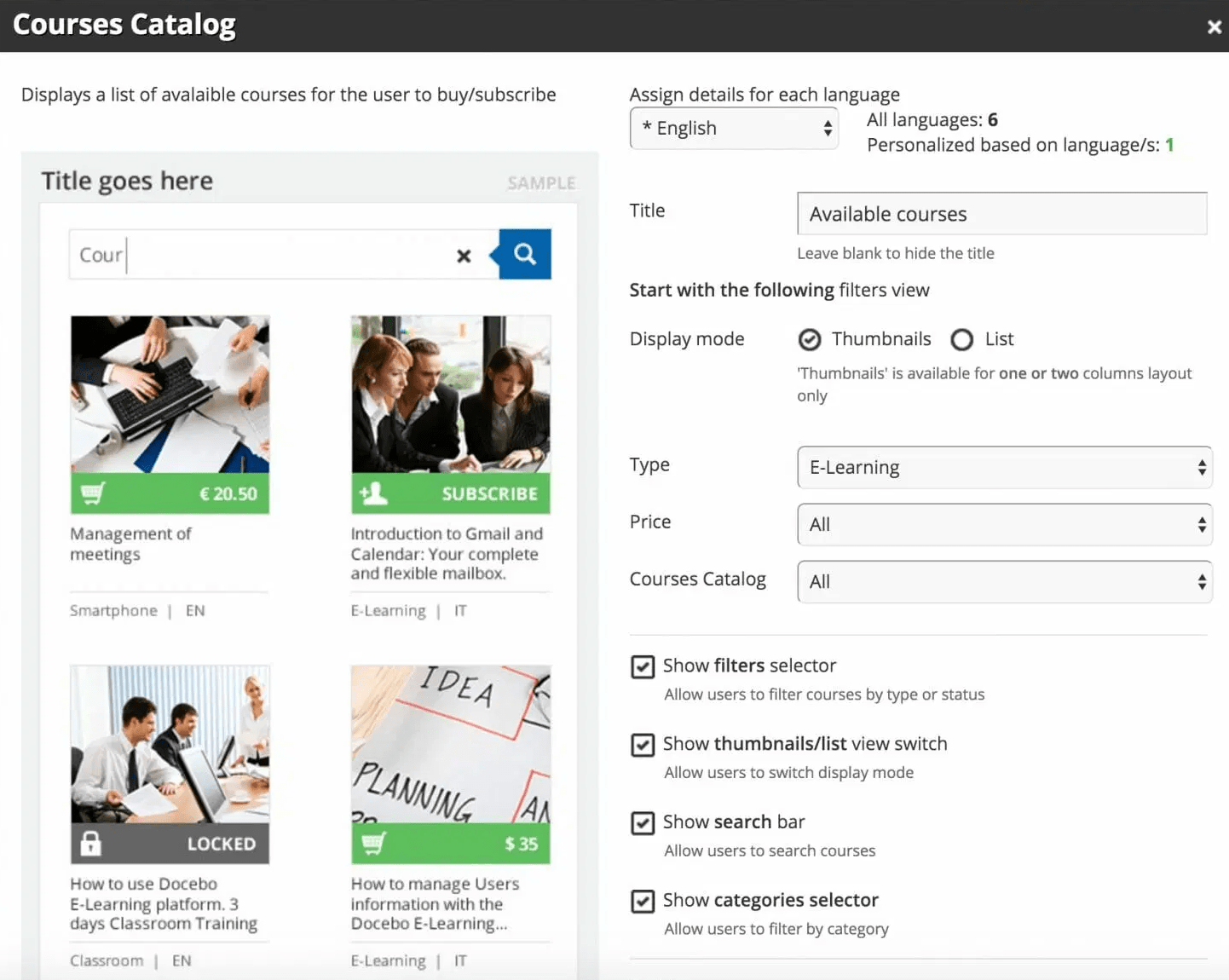
Docebo had been on my wishlist for some time, and I was fortunate enough to experience a personalized demo.
What sets Docebo apart is its excellence in AI-based learning. It utilizes AI algorithms to analyze user behaviors, preferences, and performance, providing customized recommendations and content. This approach ensures learners receive focused material, fostering a more effective educational journey.
Moreover, Docebo boasts impressive scalability. It empowers organizations to effortlessly create, administer, and distribute a vast array of training materials to numerous learners. Capable of accommodating high traffic and supporting many users simultaneously, the platform is ideal for businesses of all sizes.
What you’ll like:
- It’s a modern and user-friendly LMS, ensuring a smooth and intuitive experience.
- The platform’s flexibility allows you to customize it to align with your branding, learning content, and reporting preferences.
- It offers a variety of learning formats, gamification elements, social learning tools, and robust analytics for a comprehensive training experience.
- The training software is versatile, catering to businesses of all sizes, from small enterprises to large corporations.
- Modular features provide the flexibility to activate or deactivate functionalities based on specific user needs.
What you may not like:
- Some users might find the high pricing to be a potential barrier, making the training software less accessible for certain organizations.
- Integration complexities could be a challenge, potentially requiring technical expertise and additional resources to navigate effectively.
Pricing:
$25,000/year
3. Moodle – Best for Open-Source Learning
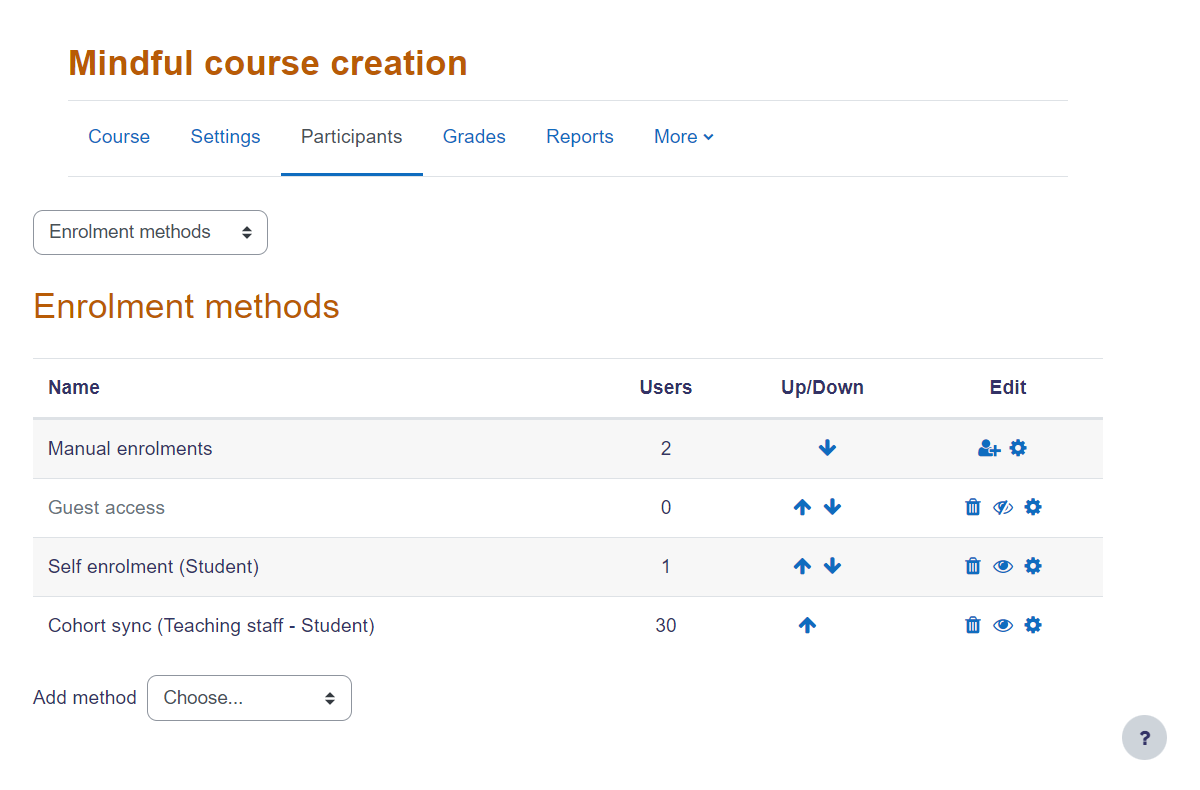
Moodle, being an open-source LMS, offers the flexibility of customization through modifications in its source code.
My personal experience with Moodle was remarkable. It allowed me to effortlessly create and manage a variety of course types, including instructor-led, self-paced, blended, or entirely online formats. It also facilitates collaborative learning through features like forums, wikis, glossaries, and database activities.
Other beneficial features I discovered were accessibility tools, clear learning pathways, competency-based education, badges and certificates, and interactive course elements.
What you’ll like:
- There are rich customization features, empowering instructors and learners to tailor courses to meet their specific needs.
- It supports the LTI (Learning Tools Interoperability) standard, simplifying integration with other educational applications.
- A robust and active community that continuously contributes to its development by sharing plugins and integrations
- Moodle 4.0, the latest version, lets learners easily track enrolled courses and progress through the overview block and track deadlines using the timeline block.
What you may not like:
- The reporting feature might be seen as limited by some users, providing less in-depth insights.
- Course engagement tracking could be enhanced to provide more comprehensive and detailed information.
- The scheduling management system might benefit from improvements to enhance organization and planning capabilities.
Pricing:
Free version available. Starts at $122.13/year. 50 users. 250 MB storage
4. Seismic Learning (formerly Lessonly) – Best for Sales & Customer Service Training
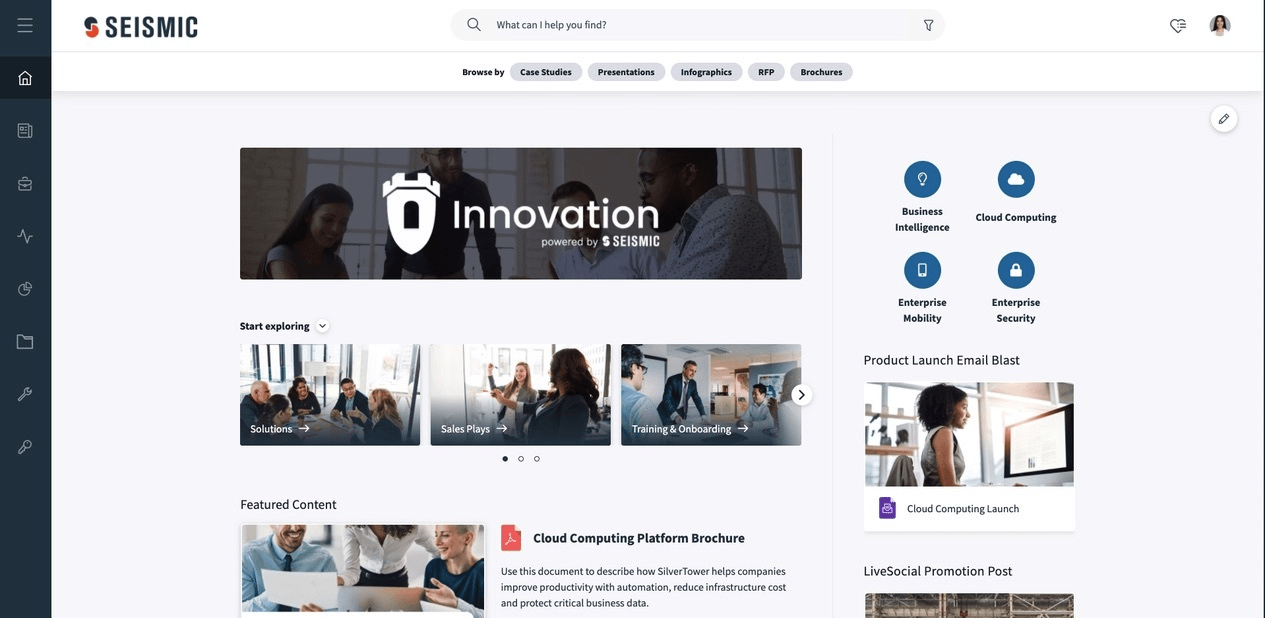
I’ve been trying out Seismic Learning since it was known as Lessonly. As stated on its website, the essence remains the same with just a “New name. Same great product.”
I found this training software ideal for creating engaging training content and offering personalized coaching. It’s also perfect for live training sessions for remote teams.
Designed for training teams in client-facing roles like sales and customer service, Seismic Learning facilitates a holistic learning approach with features like blended & instructor-led training, interactive knowledge checks, certifications, practice scenarios, partner role plays, skill assessments, and more.
What you’ll like:
- You can quickly become familiar with the layout and functionalities of this online training software, ensuring a smooth learning curve.
- It effectively streamlines sales learning and coaching processes while offering opportunities to practice essential skills.
- The LMS can scale to meet your organization’s evolving needs, making it a suitable long-term solution.
- It provides easy-to-use content creation tools, facilitating the development and updates of training materials, quizzes, and assessments.
What you may not like:
- There’s no filter for lesson history, which could have made it easier for users to revisit older lessons.
- The platform has limited options when it comes to customizing text sizes and colors.
Pricing:
Custom pricing.
5. Litmos – Best for External Training
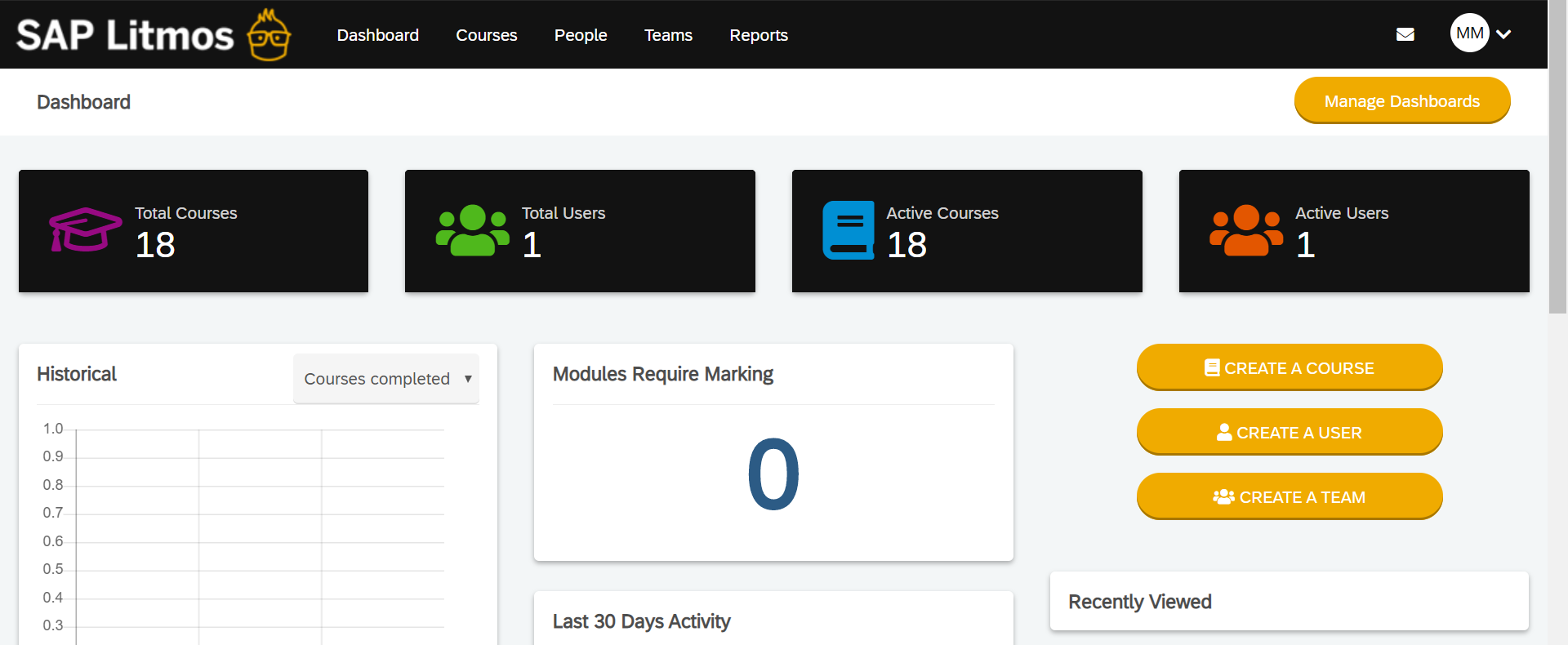
Renowned for its user-friendliness, scalability, and comprehensive features, Litmos caters to a diverse range of organizations, including Fortune 500 companies, educational institutions, and government entities, with a global user base exceeding 30 million.
During my exploration of Litmos through a free trial, I discovered its exceptional capabilities for crafting engaging online courses and programs. The platform’s intuitive user interface, incorporation of rich multimedia elements, and options for personalization, along with powerful analytics and reporting tools, all contribute to its appeal.
Additionally, its engagement tracking features are invaluable in monitoring user interactions, providing insights that are crucial for refining courses and content.
What you’ll like:
- Interactive features, such as videos, quizzes, exercises, multimedia integration, and assessments.
- The LMS helps learners continuously identify their strengths and weaknesses and hone their skills through 360-degree feedback from managers, peers, and customers.
- Custom branding to create more consistent and engaging learning experiences.
- The training software makes it easy to automate user creation and assignments.
What you may not like:
- Sometimes, there is a time lag between a customer’s initial contact and the response they receive from the support team.
- New product features are not released as frequently as expected.
Pricing:
Starts at $6 per user/month for 150-500 users.
6. TalentLMS – Best for Custom Employee Training
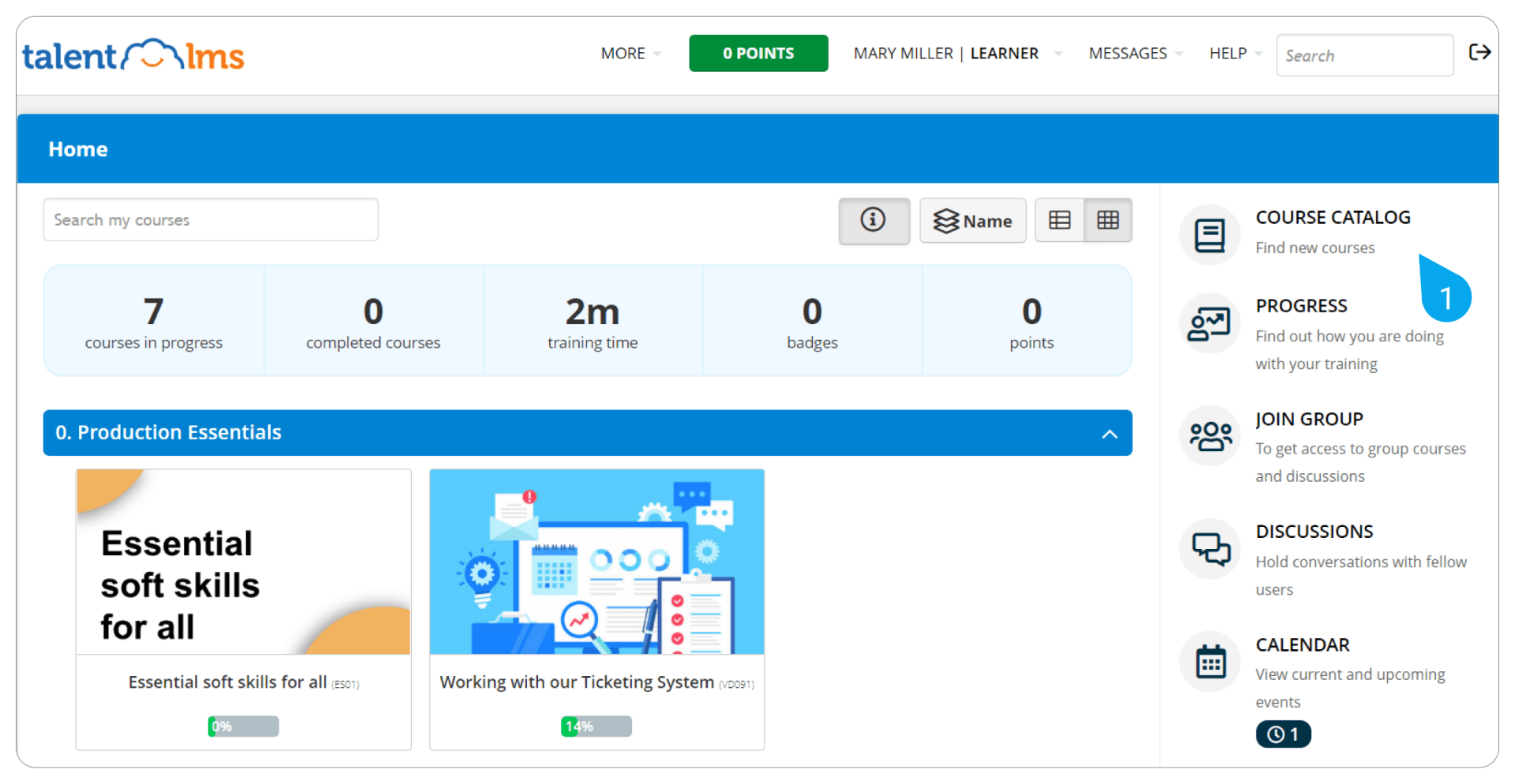
TalentLMS is tailored for small to medium businesses (SMBs) and training organizations, offering deployment-ready solutions across various industries. It simplifies implementation with a 10-step project plan, ensuring a quick and successful setup from strategizing the implementation process to designing user experiences.
TalentLMS’s capabilities include building courses from scratch using diverse media and supporting self-paced, instructor-led, and blended learning formats.
Additionally, it includes an assessment engine for quizzes and surveys, customizable learning paths based on individual skills and goals, and tools for conducting online surveys to gather feedback and identify areas of improvement.
What you’ll like:
- The learning environment is straightforward and simple to configure.
- You’ll find plenty of valuable features and customization choices.
- There’s a comprehensive online support system, including product updates, video tutorials, blogs, and a knowledge base.
- The support team is consistently accessible, responsive, and dedicated to resolving issues promptly.
What you may not like:
- The available payment gateways are limited to PayPal and Stripe.
- Improvements can be made to streamline certification management.
Pricing:
Starts at $69/month/up to 40 users.
7. LearnUpon – Best for Delivering Impactful Training
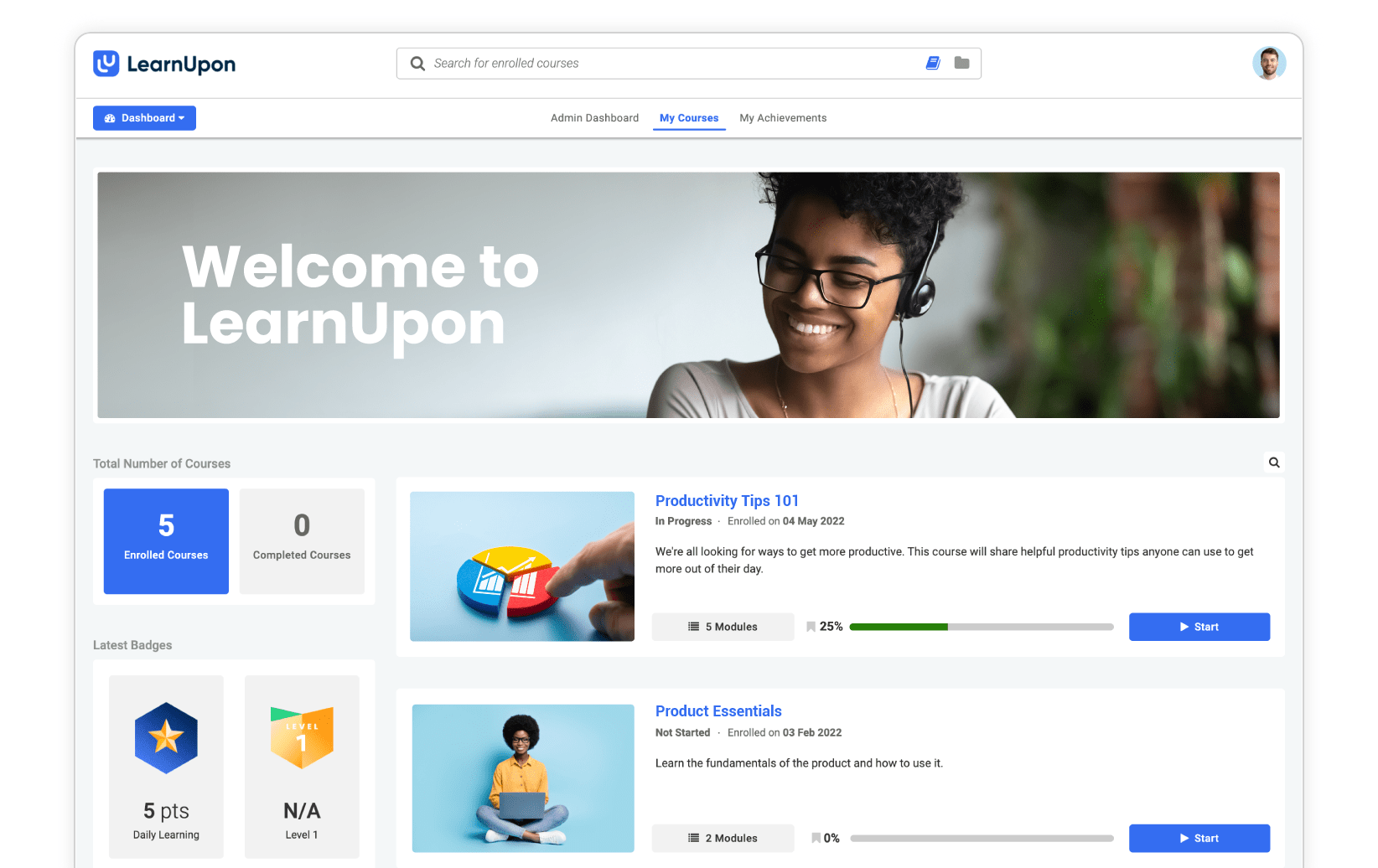
LearnUpon is a versatile training software that accommodates various groups within a single system, which I found quite beneficial. It addresses the varied needs of training companies and SMEs, including onboarding, skill development, and compliance training, and is also ideal for training the extended enterprise.
A feature that stands out is its ability to automate course enrollment, significantly easing the workload for administrators. I also loved how simple it was to create custom training content and gather feedback.
Further, LearnUpon is adept at providing tailored learning environments for diverse audiences and offers seamless integration with everyday tools, facilitating effortless data management.
What you’ll like:
- Comprehensive training materials, including documentation and webinars
- Support for gamification elements like levels, badges, and leaderboards enhances engagement.
- With support for over 20 preconfigured languages, language barriers in training are eliminated.
- The platform’s robust reporting enables users to assess the impact of their employee training programs effectively.
What you may not like:
- Basic content authoring capabilities may not suffice for organizations with advanced content creation needs.
- If a course or test is updated, there’s no option to retake it.
Pricing:
$599/month for 50 to 150 users. 1 portal, custom branding, 24/7 support, and more.
8. iSpring Learn – eLearning software for PowerPoint
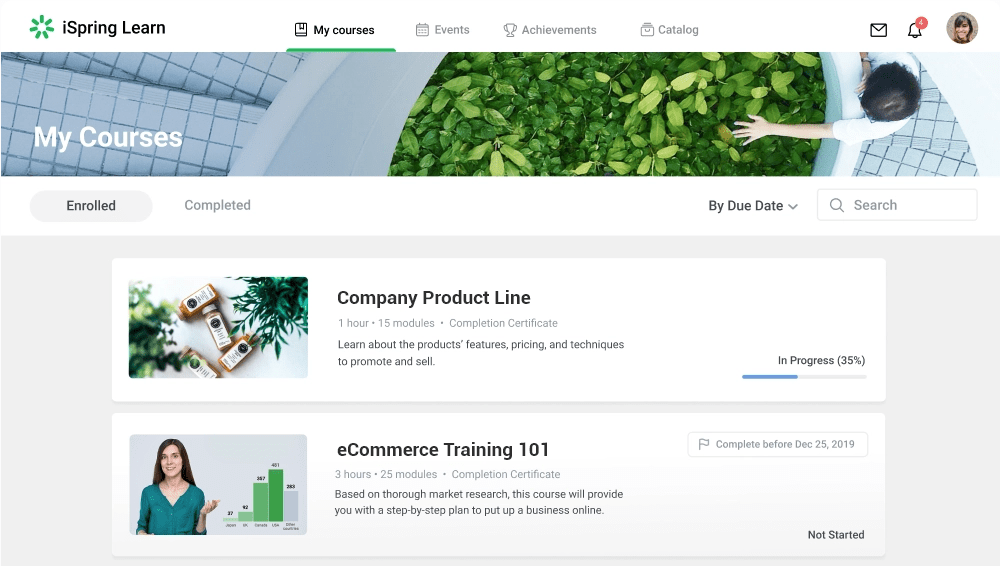
When I tested iSpring Learn, I was quite interested in how its authoring tools stacked up against other similar tools. My findings were impressive. This employee training system simplifies content creation with its authoring toolkit, enabling quick development of eLearning courses and quizzes.
I was able to tailor the content to fit my business and branding needs effectively. Additionally, converting PowerPoint presentations into interactive online courses was straightforward.
Features like video lectures, interactions, assessments, a content library, an adaptive player, and online collaboration stood out. These are valuable for anyone seeking a comprehensive eLearning authoring solution.
What you’ll like:
- A systematic approach to creating and structuring online training content
- The convenience of uploading videos, SCORM files, PDFs, presentations, and creating quizzes all in one place
- An uncomplicated tab system with intuitive labels for seamless site navigation
- Regular updates, ensuring ongoing development and improved features
What you may not like:
- Limited flexibility and customization options in the reporting feature, necessitating more filtering choices
- The manual recording of attendance in live training sessions can be challenging, particularly with a large number of participants.
Pricing:
Starts at $2.29/user/month. iSpring Suite authoring toolkit, analytics, and training & content management.
9. Absorb LMS – Best for Complex Training Needs
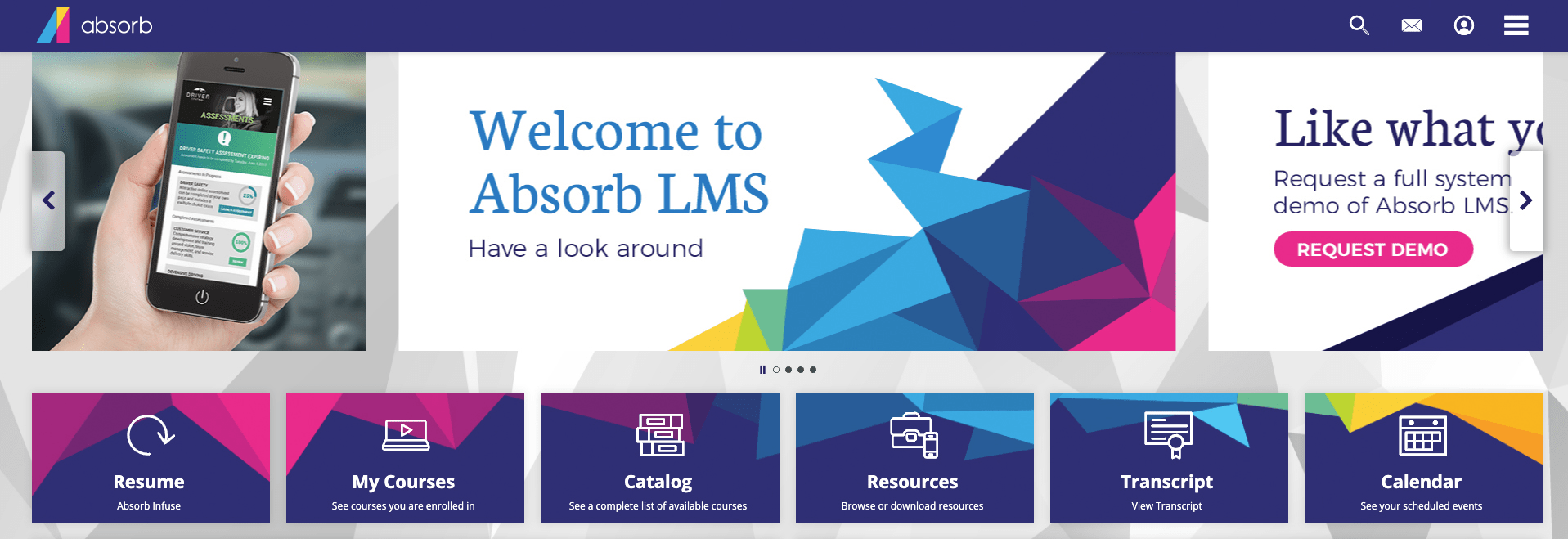
I included Absorb LMS in this list of employee training tools not just for its widespread recognition but also because it truly excels in fostering learning. It’s a versatile LMS, suitable for a wide range of organizations, and its adaptability is a key strength, making it applicable for various use cases.
For associations, Absorb LMS is particularly useful in managing diverse user groups like volunteers, members, and stakeholders. Similarly, nonprofits benefit from its ability to engage different audiences, such as donors, volunteers, and beneficiaries.
The platform’s efficient tracking and reporting features are instrumental in demonstrating the impact of programs, which is essential for maintaining transparency and trust among stakeholders.
What you’ll like:
- Users frequently commend the LMS for its user-friendly interface and ease of navigation.
- The platform offers complete customization options for branding and creating unique learning experiences.
- Access to courses and materials from mobile devices enables flexible and location-independent learning.
- A wealth of product and training resources, including a comprehensive knowledge base, on-demand webinars, and detailed product documentation.
What you may not like:
- Re-enrollment of users is required following any course modifications.
- The setup and configuration process may involve some complexity.
- Scheduling recurring sessions is not possible.
Pricing:
Approx. $14,500/year for up to 500 users. Flexible pricing aligned with your needs and goals.
10. Tovuti – Best for Ready-to-Use Learning Solutions
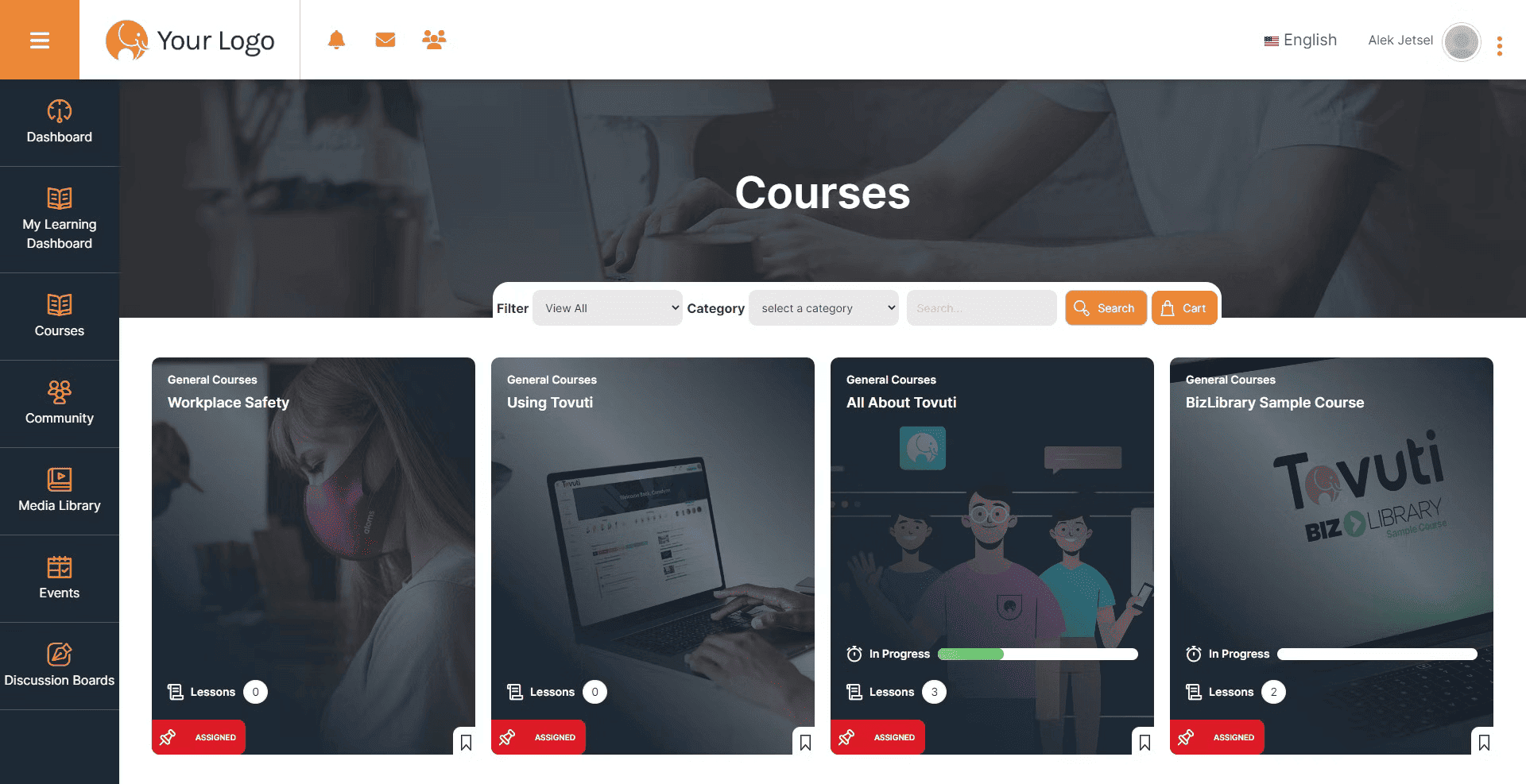
Tovuti is an LMS that’s perfect whether you’re running a small business, leading an association, or part of a non-profit. It’s recognized for its ready-to-use learning solutions, making it a great choice for those in need of an effective learning management system.
This platform is quick to set up – you can have it operational in just a few hours, integrating smoothly with your current operations. Plus, it offers branding and white labeling options for immediate use, so it fits right in with your organization’s image.
It comes packed with features for course creation, offering a range of tools to build and manage online courses. For learner engagement, it includes gamification, interactive assessments, social learning, and videoconferencing.
What you’ll like:
- Security and compliance are top-notch, adhering to industry standards.
- Excellent customization options let you tweak the platform’s appearance and functionality.
- Learning analytics are detailed, helping track progress and pinpoint where support is needed.
- Valuable multilingual support, especially beneficial for global organizations
What you may not like:
- The pricing is higher compared to some other LMS options.
- Customer service, although improving, can still have its ups and downs.
Pricing:
Custom pricing
11. Adobe Learning Manager – Best for AI Recommendation Engine
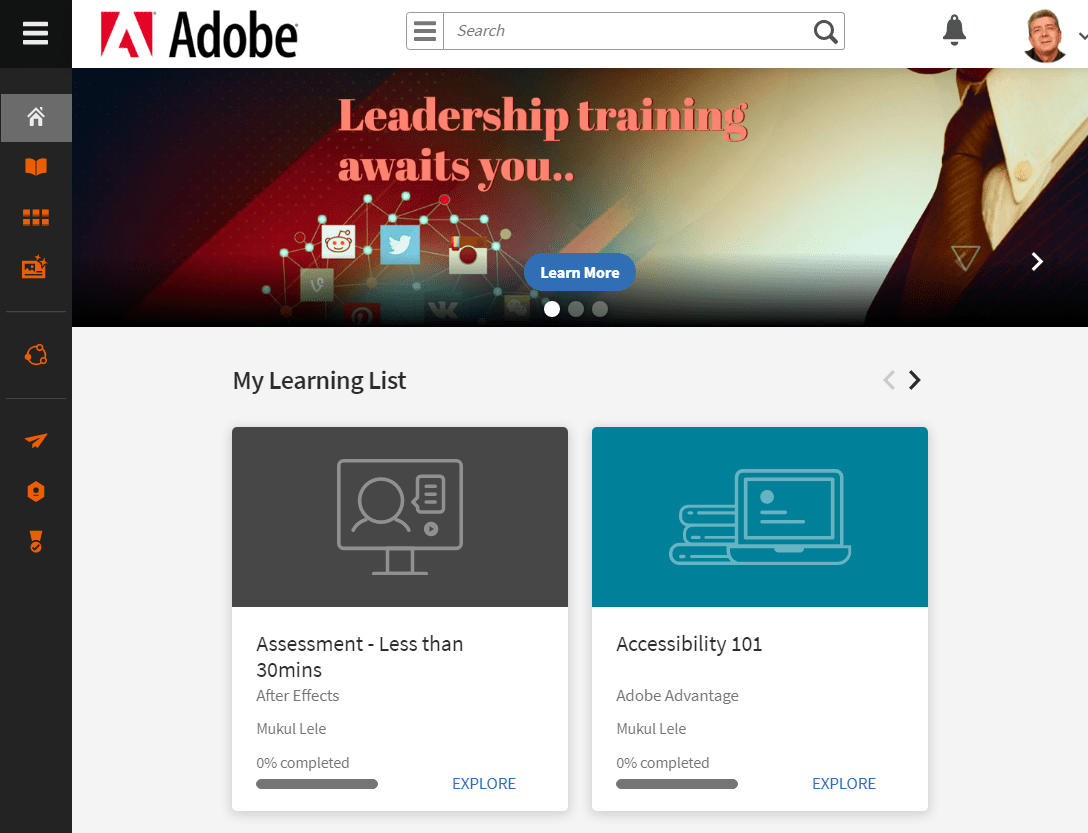
Adobe Learning Manager, formerly known as Adobe Captivate Prime, features an AI-driven recommendation engine that offers personalized learning experiences through configurable, parameter-based suggestions. This engine leverages industry data to boost learner engagement and address educational gaps.
Organizations can utilize it to foster skill-focused learning plans, support re-skilling initiatives, and cultivate a competent, well-informed workforce.
Adobe Learning Manager also offers a ‘Headless LMS’ capability, allowing seamless integration with other systems and applications. Additionally, its compatibility with numerous systems and applications broadens its applicability, and the gamification features add a competitive edge to learning, making it more engaging and fun.
What you’ll like:
- The LMS’s user-friendly design and its remarkable versatility
- It has a feature akin to Netflix, suggesting courses based on learner interests.
- As a Learning Experience Platform (LXP), it engages learners in a variety of ways.
- Being fully SCORM compliant, it ensures seamless integration and compatibility with various learning content standards.
What you may not like:
- Users may find themselves needing to clear their cache and history more frequently to resolve issues.
- Canceling a subscription incurs an associated fee.
Pricing:
The team plan starts at $45.25/month/license
12. 360Learning – Best for Collaborative Learning
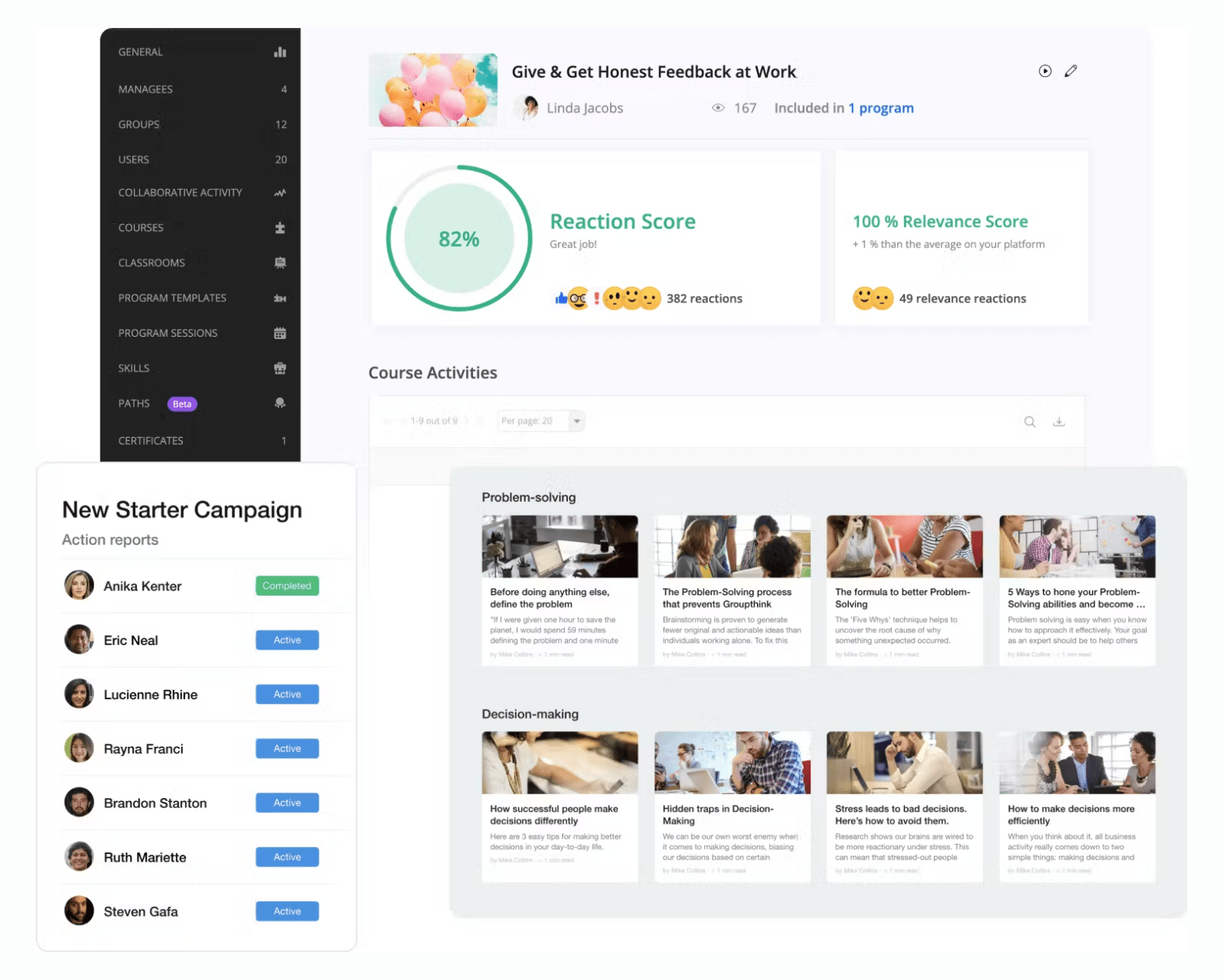
What really attracted me to 360Learning is its emphasis on collaborative learning for team training, a feature that distinguishes it in the market.
The platform creates a space where learners can engage collaboratively, sharing experiences and best practices. This approach is particularly beneficial for team training, as it fosters mutual support among team members in learning and skill application.
Alongside its collaborative learning environment, 360Learning also offers essential features such as interactive content and personalized learning paths, similar to other tools on this list. The software is designed for ease of use, allowing anyone to easily navigate and locate the information they need.
What you’ll like:
- Establishing a collaborative learning culture, where learners also act as teachers, is effortlessly achievable.
- 360Learning courses boast an impressive 91% completion rate on average.
- Consistently attains top rankings on prominent review sites such as Capterra and G2.
- The LMS empowers you to address new learning requirements promptly.
- Features for optimizing courses facilitate trainers in making real-time improvements through A/B split testing and tracking.
What you may not like:
- To create more advanced content, users may need to rely on external tools.
- Customizability of the reporting, especially in terms of viewing user data on the dashboard, may have some limitations.
Pricing:
$8/registered user/month. Up to 100 users a month and access to best-in-class resources and support.
13. Canvas LMS – Best for K-12
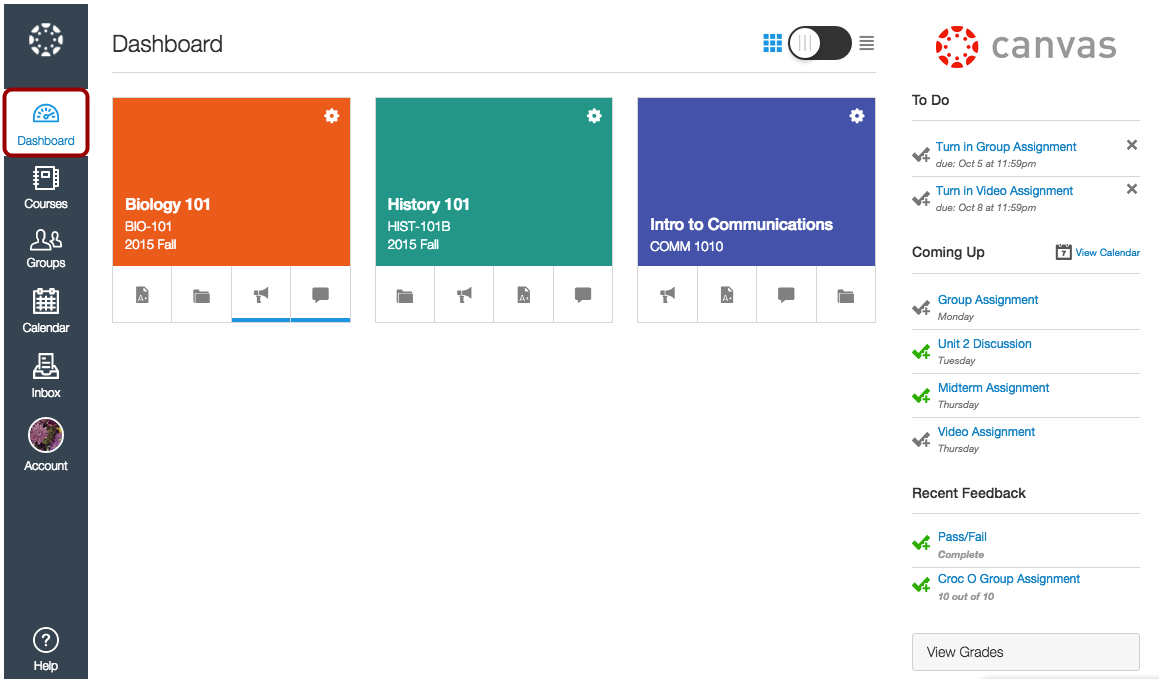
Canvas LMS enables effective employee training at any scale, which is ideal for corporate trainers and eLearning developers. It simplifies the creation of engaging courses with features like interactive videos and targeted feedback loops.
Noted for its user-friendly tools, Canvas is designed to train and inspire employees regardless of their location or role. I found this tool ideal for creating an engaging learning space and enhancing employee skills.
Other top features of this training software include diverse quiz formats, personalized Mastery Paths, the Immersive Reader for improved accessibility, and collaboration tools for effective communication.
What you’ll like:
- It’s relatively user-friendly, making navigation and usage more straightforward.
- Effortless integration with third-party tools and systems.
- Scalability that aligns with your business expansion pace.
- Assured privacy and security measures for safe learning environments.
What you may not like:
- There is room for improvement in the SpeedGrader feature, which could enhance grading efficiency.
- Occasional delays in announcements and messages may disrupt communication.
- Periodic maintenance downtime could affect continuous accessibility.
Pricing:
Starts at $0 (no course templates)
14. eFront LMS – Best for Complex Learning Ecosystems
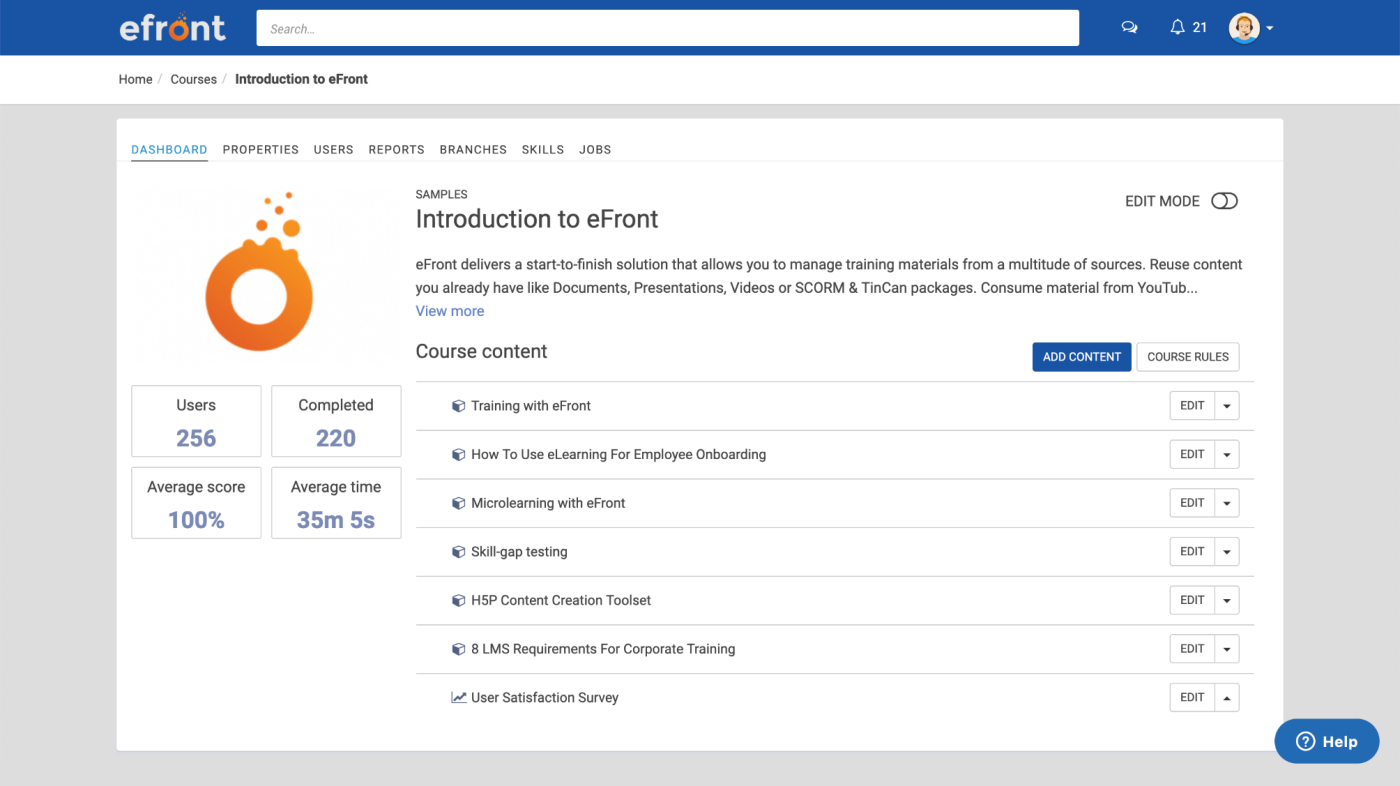
When I first encountered eFront, I realized it was far from just another software tool. This adaptable learning management system is expertly crafted to meet the intricate needs of complex learning ecosystems. It’s perfect for enterprises seeking to manage courses and nurture talent, fostering a culture of continuous learning.
This not only helps employees thrive but also drives business success. Similarly, for government agencies, eFront bridges knowledge gaps with streamlined, compliant training, enhancing public service skills.
eFront’s blended learning supports both online and offline activities. Its robust security includes encryption and single sign-on. The mobile-optimized platform ensures learning on the go while built-in enterprise features and e-commerce readiness add versatility.
What you’ll like:
- It’s a customizable training platform that seamlessly aligns with your organization’s unique requirements.
- The platform holds ISO/IEC certification and complies with GDPR standards for data protection.
- The LMS offers a combination of usability, simplicity, and tailored solutions to meet specific needs.
- It supports the simultaneous delivery of online and offline learning activities through blended learning.
What you may not like:
- Challenges may arise when migrating data to eFront from another LMS.
- Some features or sections of the LMS may lack adequate documentation or have outdated information, potentially affecting usability.
Pricing:
$1,200/month. Billed annually. Supports up to 1,000 registered users.
15. Cornerstone Learning – Best for Very Large Enterprises
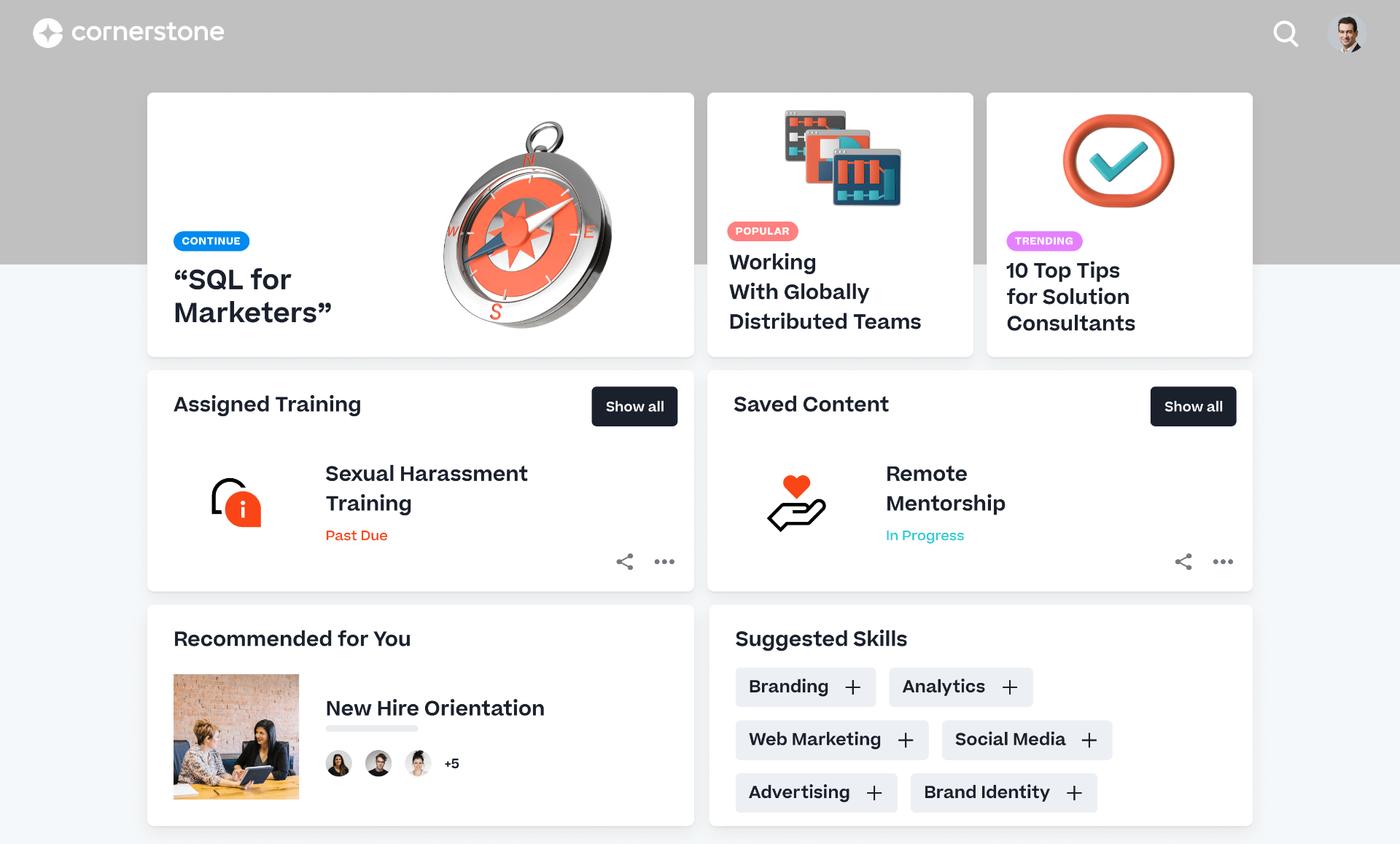
As an e-learning expert, Cornerstone Learning impressed me with its tailored approach. This LMS excels in personalizing the educational experience, integrating learning with individual growth and skills. It customizes the journey for each user, boosting relevance and impact.
Key features include a Learning Experience Platform that aligns content with unique career needs and Skills AI, which identifies and suggests vital skills. Its multi-modality training supports various content types, enhancing the learning experience.
Additionally, Cornerstone’s localization and multi-language support make it globally accessible. The mobile learning feature allows users to access content on different devices, catering to the modern learner’s need for flexibility.
What you’ll like:
- You’ll find excellent reporting capabilities with valuable data insights.
- Enjoy quarterly software updates to keep your system current.
- The level of customization available to administrators for portal management is impressive.
- You can use Skills AI to identify sought-after skills and offer learning recommendations.
What you may not like:
- At present, the LMS lacks automation features that could simplify repetitive tasks.
- The groups functionality has been awaiting an update for an extended period, potentially impacting user experience.
Pricing:
Starts at $6/user/month.
Training Software Buyer’s Guide
Now that you’ve explored the top online training software options, let’s delve deeper into them with this comprehensive training software buyer’s guide. It will equip you with all the essential insights and considerations to select the perfect solution for your team’s unique training needs.
What Is Training Software?
Training software, also known as a training management system or a learning management system, is a software application that enables trainers to develop comprehensive courses, lessons, and assessments and allows learners to access and complete these materials efficiently.
Online training tools encompass a range of features that aid in designing courses, assigning training programs, and tracking learners’ progress. The best training software can be customized to meet specific organizational needs and may offer course registration, testing, certification tracking, conferencing, and other advanced features.
Why Is Training Software Needed?
In today’s fast-paced business environment, traditional training methods can be inadequate. Here’s why training software is essential:
- Customization & Flexibility: Training software platforms allow for tailored training programs that suit different learning styles and schedules, offering flexibility and convenience to learners.
- Scalability: Training software can accommodate a handful to thousands of users, making it ideal for both small businesses and large corporations.
- Efficiency & Effectiveness: With streamlined processes and interactive content, training software makes learning more engaging and effective, leading to better retention and application of knowledge.
- Anytime, Anywhere: Training software transcends geographical and time constraints, allowing learners to access courses and tests whenever and wherever convenient, across various devices. This flexibility caters to modern lifestyles and diverse schedules, enhancing learning accessibility beyond the traditional classroom setup.
Training software thus plays a crucial role in enhancing the overall learning experience and meeting the diverse training needs of modern organizations.
Get Free Employee Training Software — All Features, Forever.
We've helped 567 companies train 200,000+ employees. Create courses in under a minute with our AI LMS or use 200+ ready-made courses on compliance, harassment, DEI, onboarding, and more!
Types of Online Training Software
Online training tools encompass a variety of solutions, each designed to address different educational and developmental needs within an organization:
- Learning Management Systems: These platforms are the backbone of many training programs, offering a centralized system for managing, delivering, and tracking training. LMSs are versatile, supporting a wide range of content types, and often include features for assessment, reporting, and certification.
- Course Authoring Tools: Essential for organizations looking to develop unique content, these course authoring tools enable the creation and customization of training materials. They often feature intuitive design interfaces and support various multimedia elements, enhancing the learner’s engagement.
- Corporate Learning Platforms: Specifically designed for professional development, these platforms provide a range of pre-built courses and training materials tailored to corporate environments. They often integrate with other corporate systems and may include features for career development and skill tracking.
- Microlearning Platforms: Focused on delivering short, targeted learning modules, these platforms are ideal for skill reinforcement and just-in-time training. They are especially effective for busy professionals who need to fit training into a hectic schedule, making them invaluable for business growth.
In addition to these, specialized training software caters to specific needs:
- Technical Training Software: Designed for IT and engineering fields, these tools focus on developing specific technical skills and often include hands-on practice simulations.
- Compliance Training Software: This type ensures employees understand and adhere to industry regulations and standards regarding workplace safety and compliance matters, often featuring tracking and reporting for compliance purposes.
- Sales Training Software: Tailored for sales professionals, these tools emphasize skills and strategies crucial for effective selling, including customer engagement and negotiation techniques.
- Language Training Software: Beneficial for companies with a global presence, these platforms focus on language learning, which is essential for effective communication in a multilingual environment.
Key Features of Training Software
Training software tools offer a suite of functionalities to manage and organize the training process effectively. Key features include:
- Course Management: Facilitate creating and publishing courses, managing course materials, setting prerequisites, and configuring course settings. This feature allows the development of engaging online content using multimedia formats like videos, images, and quizzes.
- Tests & Assessments: Enables creation of various assessment types, like multiple-choice or essay questions, to evaluate learner understanding and identify areas needing additional support.
- Learning Paths: The best training tools allow the grouping of courses or activities into curriculums or sequences to create structured, customizable learning experiences tailored to individual learner needs.
- Learners Portal: Provides a dedicated virtual classroom for learners to manage their training schedule, track progress, access assessment results, and engage with other learners and trainers.
- Training Administration: Training software tools manage the course catalog, schedule training courses, oversee user profiles and enrollment, and generate reports on progress and completion.
- Multilingual Support: Essential for global reach, this feature allows training in multiple languages, enhancing accessibility and inclusivity for learners of diverse linguistic backgrounds.
- Reports & Certification: Training software typically includes reporting tools for tracking progress and performance, along with certification to acknowledge and validate achievements.
Watch: How to Train Large Groups With Training Software
This comprehensive set of features ensures that training software can cater to a wide range of educational and developmental needs in an organizational setting.
Benefits of Training Software
The implementation of training software can significantly contribute to the development of a skilled and knowledgeable workforce, driving organizational growth and success. Here’s how:
- Enhanced Learning & Retention
- Upskilling Employees
- Cost-Efficiency & Reduced Training Costs
- Flexibility, Convenience & Employee Engagement
- Scalability
- Data-Driven Insights & Simplified Progress Tracking
- Streamlined Compliance Training
1. Enhanced Learning & Retention
Training software’s interactive interfaces make learning more engaging, significantly enhancing information retention. Features like simulations, video tutorials, and interactive quizzes cater to various learning styles, ensuring that learners not only understand but retain the training material.
This approach is especially beneficial in complex skill areas where hands-on practice and repetition are key.
Watch: How Tupperware Improved Employee Training With an LMS
2. Upskilling Employees
Training software may offer an extensive range of materials and resources, helping employees to continuously improve their skills and knowledge. From industry-specific training to general skill enhancement, employees have the opportunity to learn and grow in their respective fields, which is crucial in today’s rapidly evolving job market.
Watch: How CDPH Improved Employee Performance Using Training Software
3. Cost-Efficiency & Reduced Training Costs
By reducing the need for physical training materials, travel, and venue costs for in-person sessions, training software presents a more economical option. The shift to digital resources not only cuts down direct expenses but also minimizes the time away from work typically associated with traditional training methods.
Watch: How KDD Transformed Employee Training & Significantly Reduced Costs
4. Flexibility, Convenience & Employee Engagement
Training software allows employees to learn at their convenience, fitting training into their schedules without disrupting their work. This flexibility boosts engagement by empowering employees to take charge of their learning. Personalized training paths also contribute to higher motivation and job satisfaction.
Watch: How Solenta Aviation Trained Its Pilots & Cabin Crew Remotely
5. Scalability
Top training software are adaptable to different organizational sizes, making them equally effective for small businesses and large enterprises. This scalability is crucial for businesses as they grow, ensuring that their training capabilities can expand to accommodate an increasing number of employees without losing effectiveness.
Watch: How Child Lane Easily Trains & Certifies 500+ Childcare Providers
6. Data-Driven Insights & Simplified Progress Tracking
Comprehensive analytics capabilities allow organizations to track and evaluate the effectiveness of their training programs. Real-time progress tracking and detailed reports provide insights into employee performance, identifying strengths and areas for improvement. This data-driven approach enables more informed decisions about future training needs and strategies.
Watch: How to Analyze Training Course & Quiz Results
7. Streamlined Compliance Training
Training software is indispensable in sectors like healthcare, finance, and manufacturing, automating the delivery and tracking of mandatory regulatory training. This ensures adherence to stringent industry standards, reduces legal risks, and upholds operational integrity in compliance-focused environments.
Watch: How CheckPLD Uses ProProfs for AML/FT Training & Certification
How to Choose the Right Training Software
Choosing the right training software is a pivotal decision for any organization looking to enhance its learning and development initiatives. The right software should not only align with your organizational objectives but also adapt to your evolving training needs. It’s a balance of functionality, user experience, scalability, and cost-effectiveness.
Get Free Employee Training Software — All Features, Forever.
We've helped 567 companies train 200,000+ employees. Create courses in under a minute with our AI LMS or use 200+ ready-made courses on compliance, harassment, DEI, onboarding, and more!
What Are the Selection Criteria for Training Software?
When selecting training software, it’s crucial to consider a range of factors to ensure the chosen solution aligns with your organizational needs and enhances learning outcomes. Here’s a detailed look at the key selection criteria:
1. Organizational Alignment:
Corporate/Business Specialization: It’s important to select software that aligns with your specific industry or business needs. This means choosing a platform that offers training relevant to the job roles and responsibilities within your organization.
Certification Feature: The ability of the software to offer certifications upon course completion not only validates the skills and knowledge acquired by the employees but also contributes to their professional growth and development.
SCORM Compliance: Ensuring the software adheres to the Shareable Content Object Reference Model (SCORM) standards is crucial for compatibility. This compliance ensures that eLearning content can be easily shared and reused across different platforms.
2. User Experience:
User-Friendliness: The software should be intuitive, with an easy-to-navigate interface. This enhances user engagement and ensures that employees can use the software effectively without extensive training.
Learners’ Portal: A central hub for training resources, schedule management, progress tracking, and problem identification is essential. A well-designed learners’ portal enhances the overall learning experience and fosters a sense of autonomy among users.
Mobile Accessibility: In today’s mobile-first world, it’s important for the software to be accessible on various devices. This ensures that learning can happen anytime and anywhere, providing flexibility to the learners.
3. Content Management:
Customization Options:The ability to tailor the training experience is crucial. This includes customizing the content to align with specific organizational goals and branding, which ensures that the training is relevant and resonates with the learners.
Content Quality & Variety: The effectiveness of training greatly depends on the quality and variety of content. The software should offer a wide range of high-quality training materials that cater to different learning styles and preferences.
Gamification: Incorporating game-like elements into learning can significantly enhance engagement and enjoyment. This approach is known to improve participation and completion rates, making the learning process more enjoyable and effective.
4. Training Delivery:
Synchronous/Asynchronous Training: The software should support both real-time, instructor-led training (synchronous) and self-paced, on-demand learning (asynchronous). This flexibility allows organizations to choose the mode of training that best suits their operational dynamics and employee preferences.
5. Scalability & Integration:
Scalability: As your organization grows, the training software should be able to accommodate an increasing number of users and more complex training scenarios without any compromise in performance.
Compatibility: The ability of the software to integrate seamlessly with your existing systems, such as HR and ERP systems, is vital. This integration streamlines training processes and enhances data consistency across different platforms.
6. Analytics & Reporting:
Robust analytics and reporting tools are essential for tracking training effectiveness. These features should provide detailed insights into user progress, course completion rates, and other key performance indicators, helping you to make informed decisions about future training strategies.
7. Security & Support:
Data Security & Privacy: Given the sensitivity of training data, the software must adhere to stringent security and privacy standards. This ensures that employee information and training materials are protected from unauthorized access.
Customer Support: The level of support provided by the vendor is crucial. Look for comprehensive support services, including training for the software, a responsive help desk, and ongoing technical assistance. Good customer support can greatly influence the successful implementation and continued effective use of the software.
8. Cost Considerations:
Evaluating the total cost of ownership is important. This includes not only the initial setup and subscription fees but also any additional costs for extra features, support, and future upgrades. A cost-effective solution should align with your budget while providing a good return on investment through improved employee skills and productivity.
By carefully evaluating these criteria, you can select a training software that meets your organizational needs and enhances your workforce’s learning experience.
Pricing Structures & Budget Considerations for Training Software
Understanding the pricing structures of training software is essential for effective budgeting. Costs can vary significantly based on the features offered, scalability, and the provider’s pricing model.
How Much Does Training Software Cost?
The cost of training software can vary widely based on features, scalability, and the specific needs of an organization:
- Subscription-Based Pricing: Many training software options use a subscription model, often with monthly or annual fees. This cost can be influenced by factors such as the number of users and the breadth of features.
- Per-User Pricing: Some platforms charge based on the number of users, which can be more economical for smaller teams. However, this cost can escalate as the number of learners increases.
- Freemium Models: These offer basic functionalities for free with options for paid upgrades to access more advanced features. This model can be a good starting point for smaller organizations or for trial purposes.
- Custom & Enterprise Pricing: Larger organizations with more complex needs may require custom solutions, which often come at a higher price point. These packages might include advanced features like social learning, eCommerce management, and extensive integration capabilities.
When considering training software, it’s important to factor in not just the initial cost but also potential expenses for additional features, support, and upgrades over time. Additionally, organizations should consider the return on investment in terms of improved efficiency, productivity, and employee skill development.
Implementing Training Software
Implementing training software effectively is crucial for its successful adoption within an organization:
- Planning & Stakeholder Engagement
Begin with a clear plan that outlines the objectives and scope of the training software. Engage with stakeholders across the organization, including IT, HR, and potential end-users, to understand their needs and expectations.
- Customization & Integration
Tailor the software to meet specific organizational requirements. This may involve customizing content and user interfaces and integrating the software with existing systems for seamless operation.
- Training & Onboarding
Conduct comprehensive training for users to ensure they are comfortable with the new system. This might involve creating user guides, hosting workshops, or providing online tutorials to facilitate smooth adoption.
- Pilot Testing
Implement the software in phases, starting with a pilot test. This allows for identifying any issues and making necessary adjustments before rolling out the software across the entire organization.
- Feedback & Iteration
Collect feedback from early users and continually iterate on the software based on this input. Regular updates and improvements based on user feedback are key to ensuring the software remains relevant and effective.
- Ongoing Support & Evaluation
Provide ongoing support to users and regularly evaluate the software’s effectiveness against the set objectives. This includes monitoring user engagement, learning outcomes, and overall satisfaction with the platform.
By following these steps, organizations can ensure a smooth and effective implementation of training software, leading to better learning outcomes and higher user satisfaction.
Watch: How Niquan Energy Successfully Shifted to Online Employee Training
Future Trends & Upgrades in Training Software
As the landscape of digital learning continues to evolve, keeping an eye on future trends in training software is crucial for organizations aiming to stay ahead. Here’s a detailed overview of the top five anticipated trends in this dynamic field:
- Advanced AI Integration: Future training software is expected to incorporate more sophisticated AI. This means personalizing learning experiences to a higher degree, using AI to analyze learner performance and adapt content dynamically. AI could also predict learner needs, suggesting courses and paths before learners even recognize their gaps.
- Extended Reality (XR) Integration: The use of Virtual Reality (VR), Augmented Reality (AR), and Mixed Reality (MR) will likely increase. XR can create immersive training environments that simulate real-life scenarios, providing hands-on experience in a controlled, virtual space. This technology is particularly promising for skill-based training, like medical procedures or machinery operation.
- Adaptive Learning Systems: These systems will evolve to become more responsive, adjusting the training content in real time based on a learner’s progress and comprehension. This means that the learning path of each individual can continuously evolve, ensuring that the pace and complexity of the material are always at the optimal level for their learning.
- Blockchain for Certification & Credentialing: Blockchain could revolutionize how certifications are issued and verified. With blockchain, certificates become tamper-proof and easily verifiable, adding credibility and assurance to online learning credentials.
- Emphasis on Soft Skills Training: There’s an increasing recognition of the importance of soft skills in the professional world. Training software will likely include more comprehensive modules focusing on skills like leadership, teamwork, communication, and emotional intelligence, which are critical in diverse workplace scenarios and boost productivity.
These trends indicate a move towards more personalized, engaging, and technologically advanced training solutions. By keeping an eye on these trends, you can ensure that your training software continues to meet the needs of a modern workforce.
Get Free Employee Training Software — All Features, Forever.
We've helped 567 companies train 200,000+ employees. Create courses in under a minute with our AI LMS or use 200+ ready-made courses on compliance, harassment, DEI, onboarding, and more!
Empower Your Team With Online Training Software
Training software is more than just a tool; it’s an investment in your organization’s most valuable asset – its people. The right training software can transform the learning experience, foster a culture of continuous development, and drive organizational growth.
By carefully considering your needs, evaluating the options, and staying abreast of future trends, you can choose and implement a training software solution that aligns with your organizational goals and enhances the capabilities of your workforce.
 Tips
Tips
We’d love to hear your tips & suggestions on this article!
Get Free Employee Training Software — All Features, Forever.
We've helped 567 companies train 200,000+ employees. Create courses in under a minute with our AI LMS or use 200+ ready-made courses on compliance, harassment, DEI, onboarding, and more!


 We'd love your feedback!
We'd love your feedback! Thanks for your feedback!
Thanks for your feedback!






